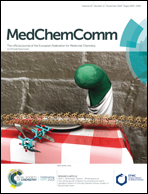Structural modification of azolylacryloyl derivatives yields a novel class of covalent modifiers of hemoglobin as potential antisickling agents
Abstract
The intracellular polymerization and the concomitant sickling processes, central to the pathology of sickle cell disease, can be mitigated by increasing the oxygen affinity of sickle hemoglobin (HbS). Attempts to develop azolylacryloyl derivatives to covalently interact with βCys93 and destabilize the low-O2-affinity T-state (deoxygenated) HbS to the polymer resistant high-O2-affinity R-state (liganded) HbS were only partially successful. This was likely due to the azolylacryloyls carboxylate moiety directing the compounds to also bind in the central water cavity of deoxygenated Hb and stabilizing the T-state. We now report a second generation of KAUS compounds (KAUS-28, KAUS-33, KAUS-38, and KAUS-39) without the carboxylate moiety designed to bind exclusively to βCys93. As expected, the compounds showed reactivity with both free amino acid L-Cys and the Hb βCys93. At 2 mM concentrations, the compounds demonstrated increased Hb affinity for oxygen (6% to 15%) in vitro, while the previously reported imidazolylacryloyl carboxylate derivative, KAUS-15 only showed 4.5% increase. The increased O2 affinity effects were sustained through the experimental period of 12 h for KAUS-28, KAUS-33, and KAUS-38, suggesting conserved pharmacokinetic profiles. When incubated at 2 mM with red blood cells from patients with homozygous SS, the compounds inhibited erythrocyte sickling by 5% to 9%, respectively in correlation with the increase Hb-O2 affinity. These values compare to 2% for KAUS-15. When tested with healthy mice, KAUS-38 showed very low toxicity.



 Please wait while we load your content...
Please wait while we load your content...